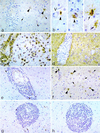Inducible nitric oxide synthase and nitrotyrosine are found in monocytes/macrophages and/or astrocytes in acute, but not in chronic, multiple sclerosis
- PMID: 9665945
- PMCID: PMC95596
- DOI: 10.1128/CDLI.5.4.438-445.1998
Inducible nitric oxide synthase and nitrotyrosine are found in monocytes/macrophages and/or astrocytes in acute, but not in chronic, multiple sclerosis
Abstract
We have examined the localization of inducible nitric oxide synthase (iNOS) and nitrotyrosine (the product of nitration of tyrosine by peroxynitrite, a highly reactive derivative of nitric oxide [NO]) in demyelinating lesions from (i) two young adult patients with acute multiple sclerosis (MS), (ii) a child with MS (consistent with diffuse sclerosis), and (iii) five adult patients with chronic MS. Previous reports have suggested a possible correlation between iNOS, peroxynitrite, related nitrogen-derived oxidants, and the demyelinating processes in MS. We have demonstrated iNOS-immunoreactive cells in both acute-MS and diffuse-sclerosis-type lesions. In acute-MS lesions, iNOS was localized in both monocytes/macrophages and reactive astrocytes. However, foamy (myelin-laden) macrophages and the majority of reactive astrocytes were iNOS negative. In specimens from the childhood MS patient, iNOS protein was present only in a subpopulation of reactive or hypertrophic astrocytes. In contrast, no iNOS staining was detected in chronic-MS lesions. Immunohistochemical staining of acute-MS lesions with an antibody to nitrotyrosine revealed codistribution of iNOS- and nitrotyrosine-positive cells, although nitrotyrosine staining was more widespread in cells of the monocyte/macrophage lineage. In diffuse-sclerosis-type lesions, nitrotyrosine staining was present in hypertrophic astrocytes, whereas it was absent in chronic-MS lesions. These results suggest that NO and nitrogen-derived oxidants may play a role in the initiation of demyelination in acute-MS lesions but not in the later phase of the disease.
Figures


References
-
- Adams C W, Poston R N. Macrophage histology in paraffin-embedded multiple sclerosis plaques is demonstrated by the monoclonal pan-macrophage marker HAM-56: correlation with chronicity of the lesion. Acta Neuropathol. 1990;80:208–211. - PubMed
-
- Adams C W M, Poston R N, Buk S J. Pathology, histochemistry and immunocytochemistry of lesions in acute multiple sclerosis. J Neurol Sci. 1989;92:291–306. - PubMed
-
- Beckman J S, Crow J P. Pathological implications of nitric oxide, superoxide and peroxynitrite formation. Biochem Soc Trans. 1993;21:330–334. - PubMed
-
- Beckman J S, Ye Y Z, Anderson P G, Chen J, Accavitti M A, Tarpey M M, White C R. Extensive nitration of protein tyrosines in human atherosclerosis detected by immunohistochemistry. Biol Chem Hoppe-Seyler. 1994;375:81–88. - PubMed
Publication types
MeSH terms
Substances
LinkOut - more resources
Full Text Sources
Medical

